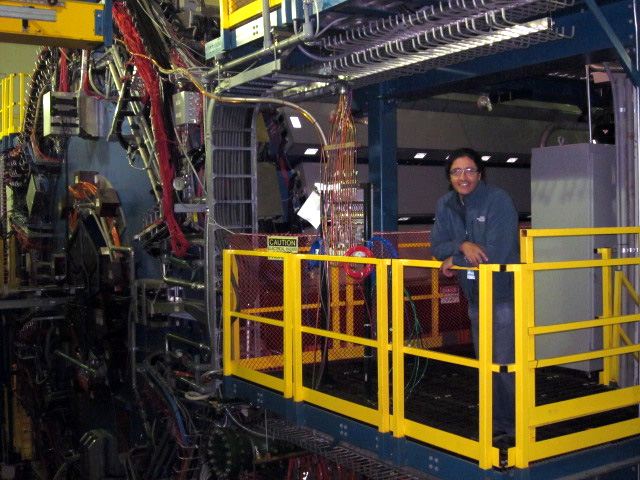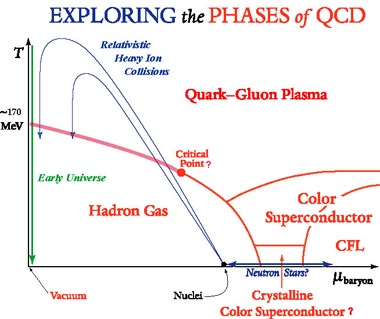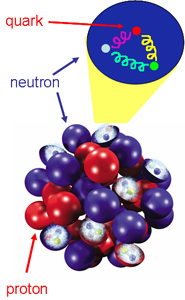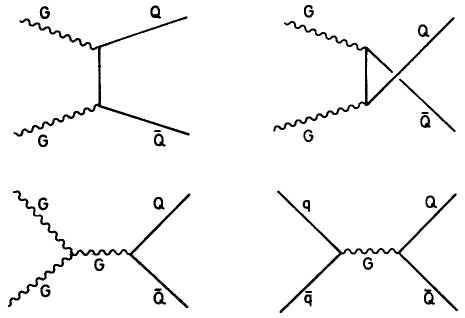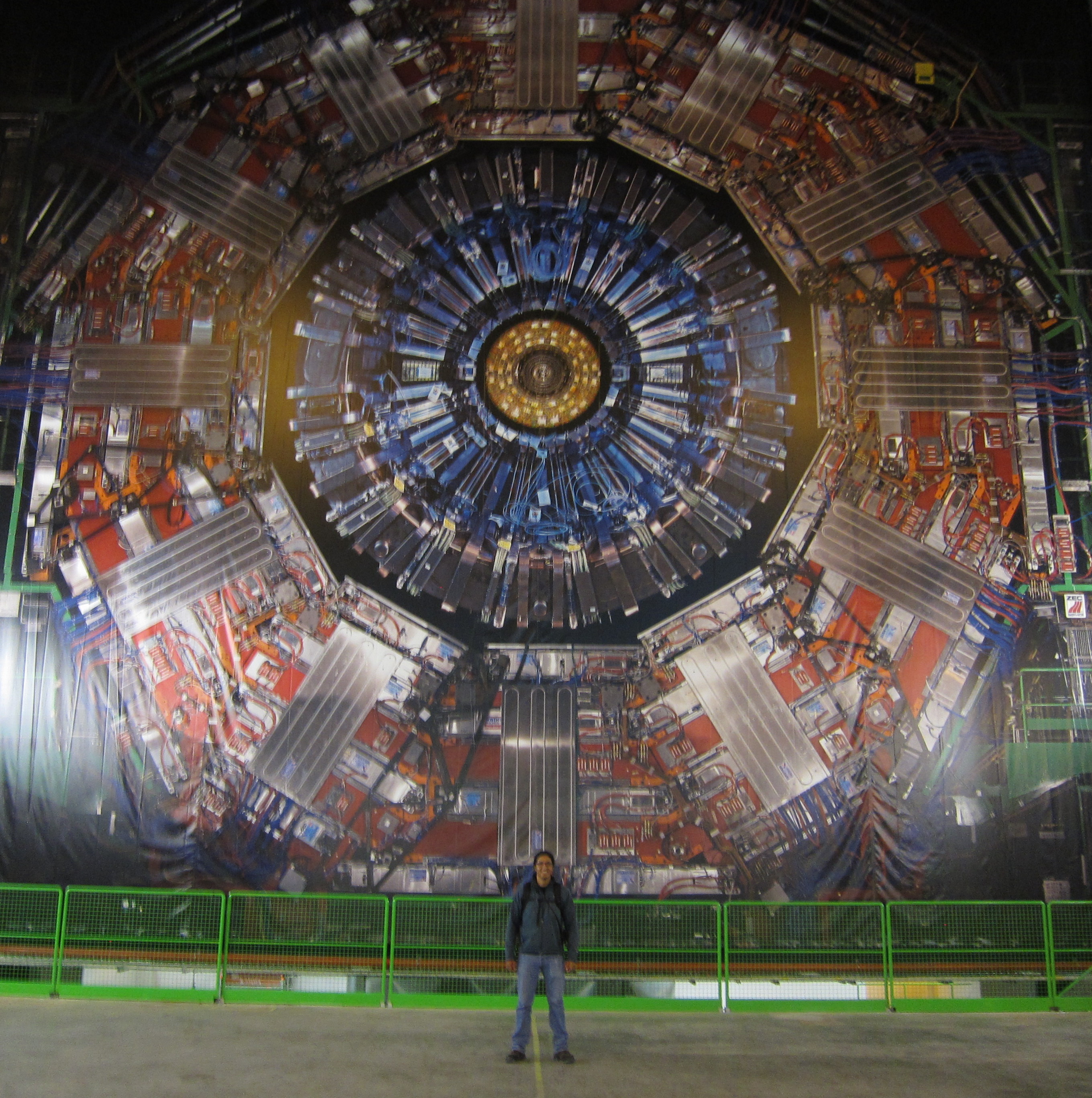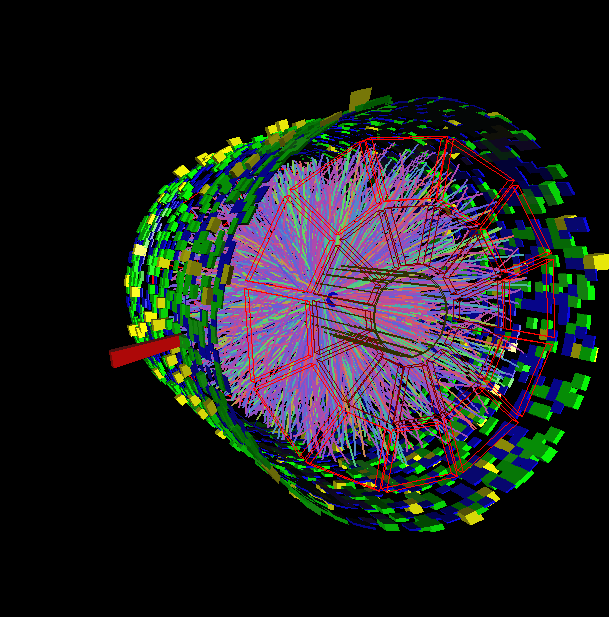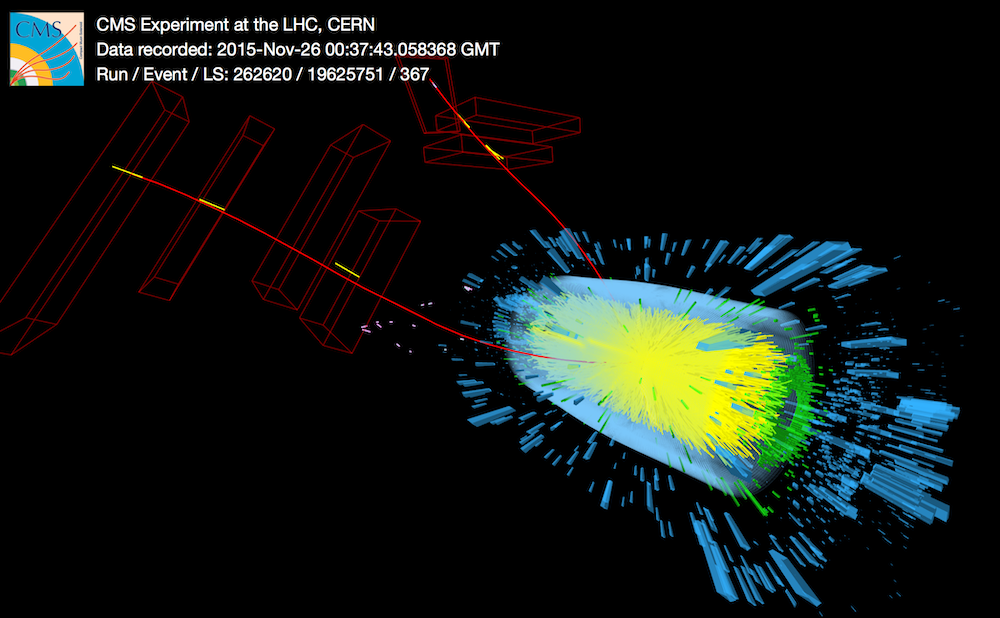Research
| Heavy Quarks in Heavy-Ion Collisions in STAR and CMS
I am interested in studying the production of heavy quarkonium states in heavy ion collisions. This is one of the studies that aims to obtain information about possible formation of a Quark-Gluon Plasma in the laboratory. The notes below are an attempt at clarifying what I mean in this two sentence summary ;-) I specially tried to make this page for graduate students, so you can get an idea on the physics questions that heavy ion research is trying to answer. I added links at the bottom to some relevant pages for more information. |
At the STAR Experiment, Brookhaven National Laboratory.
An article on my research appeared in the magazine International Innovation.
This article is suitable for a general readership. Additional information can be found on the Nuclear Physic Group page. |
| QCD & QGP
I do research in relativistic heavy ion collisions. I'm interested in studying QCD (Quantum Chromo-Dynamics), the theory of the strong interactions which fundamentally is at the heart of particles such as protons and neutrons. This is a theory whose main actors are quarks and gluons. There are many ways to study QCD and in particular in relativistic heavy ion collisions we are interested in trying to do it at a high energy density. The interesting aspect is that in our everyday world, we never see quarks and gluons, we only see the protons and neutrons formed by the complicated interaction of quarks and gluons at low energies. We say that the quarks and gluons are "confined", so that loosely speaking one can think of protons and neutrons as a bag of quarks and gluons. The understanding of the nature of confinement in QCD is the subject of the 2004 Nobel Prize in Physics. At high energies, many theoretical calculations of QCD on large dedicated computers have indicated that a very different behaviour should emerge. The expectation is that at high energies, the quarks and gluons will be the main players, able to exist by themselves, and protons and neutrons will no longer exist. The type of matter that should be formed at these high energy densities can be thought of another phase of QCD matter, and it has been dubbed the "Quak-Gluon Plasma". This is only one of the interesting aspects of QCD, as the sketch to the right illustrates. |
|
| QGP & Heavy Ions
Experimentally, we hope to reach the high-energy domain of QCD by doing collisions of heavy ions. For our purposes, heavy ions are the largest chunks of matter made out of protons and neutrons that we can conveniently obtain and manipulate in the laboratory (our technology is far away from being able to produce a collision of neutron stars at high energies!). For more than 25 years, physicists have been doing experiments colliding heavy ions to look for clues of behaviour indicative with formation of a QGP. The experiments have been gathering evidence not from doing a single measurement, but rather from studying how several different observables behave. |
The Quark-Gluon Plasma and Relativistic Heavy Ion Collisions
Above: The Nucleus of an atom contains many nucleons (protons and neutrons). The nucleons are made up of quarks and gluons. |
|
A Heavy Ion Collision It is perhaps easiest to visualize by watching. The Relativistic Quantum Molecular Dynamics (RQMD) code developed by H. Sorge can simulate these collisions. One can see an example of a Au+Au collision at a centre-of-mass energy of 200 GeV per nucleon pair and at an impact parameter of 5 fm as calculated in RQMD in the animation on the right. You can see the Au nucleus as a Lorentz-contracted pancake-shaped object moving in one direction (at about 99.995% of the speed of light, spheres look like pancakes, they are contracted 100 times in their direction of motion). Another Au nucleus pancake is moving in the opposite direction. They collide and produce hundreds of particles. It is by studying the outgoing particles that we can study the state of matter where the quarks and gluons dominate the picture, even if they do so very briefly. In the animation, the green particles left at the end are made up of a quark-antiquark pair. There are six types of quaks, and in rare occasions a heavy quark pair is made in the collisions. |
At the CMS center, at CERN. |
|
Heavy Quarks and "Quarkonium" Quarks are one of the building blocks of the Standard Model of particles and forces. They make up protons and neutrons, and also many other particles (that's why they're building blocks!). The Standard Model as we currently understand it, can be seen in a poster prepared by Berkeley Lab, shown here. In particular, my current research interest is to measure heavy quark production in heavy ion collisions. The leading-order diagrams for heavy-quark production are shown on the right. You can see that to leading order, two gluons (G) can combine to form a heavy quark-antiquark pair (Q). A light quark-antiquark pair (q) can also produce a heavy quark-antiquark pair. The bound state of a quark-antiquark pair is commonly called "quarkonium", in similar fashion as the bound state of an electron and its antiparticle, the positron, is called "positronium". Specifically, heavy quark bound states are predicted to be significantly suppressed in the presence of a Quark-Gluon Plasma in an effect similar to Debye screening in an electrolyte: the color charge between the two heavy quarks is screened by the presence of the surrounding quarks and gluons. More recently, numerical calculations of QCD have refined this picture and provided a benchmark: different quarkonium states should dissolve at different temperatures. This is exciting news: a measurement of many of these states, with information as to which states have "melted" and which have not, should give us information about the temperature reached in the high energy heavy ion collisions. The temperatures produced in such collisions should exceed 200 MeV, or 2x1012 degrees K (the temperature of the sun's core is 15x106 degrees K, about a million degrees colder by comparison). That is how hot we need to make things in order to "melt" nuclear matter and produce quark matter! For more information on quarks and other particles, you can also visit a web page at CERN with lots of information on the fundamental particles and forces: The Particle Adventure. |
Above: Leading order heavy-quark production in QCD. |
| LHC &CMS Heavy Ions
CERN, the European Laboratory for Particle and Nuclear Physics, houses the Large Hadron Collider (LHC). This is an accelerator which was originally built with two physics programmes in mind: the search for new particles, such as the Higgs Boson, and the search and characterization of the matter produced in heavy ion collisions and phenomena related to Quark-Gluon Plasma formation. The Nuclear Group at UC Davis participates in the CMS collaboration. My research interests have mainly focused in the area of heavy ions. The CMS experiment has many components, including a high-precisoin silicon tracker, as well as muon detectors. The detector is about 5 stories high! The Muon detectors are very important in the goal of measuring quarkonium states through their decay into a muon-antimuon pair. I am interested in reconstructing these states, such as the J/ψ (a bound state of a charm quark and its antiparticle) and the Υ (Upsilon, a bound state of a bottom quark and its antiparticle), through their di-muon decays in CMS to study their possible suppression as clues to the matter formed in heavy ion collisions. The heavyest quark, the top quark, is much too heavy to be produce bound states, as it decays too quickly. The bottom and the charm quarks are the next heavyest quarks, and the way they melt can give us information as to the temperature of the quark-gluon plasma. |
|
| Heavy Ion collisions in STAR and CMS
The hundreds of particles produced in the collisions seen in the detectors are shown in the Figure on the right. This is the information obtained from the tracker, a detector component which is like a giant 3-D digital camera which records the trajectories of the particles. With it, we can obtain information on the number of particles in each collision, as well as the momentum of each particle. The detectors also help to discern the identity of the particles we measure: protons, electrons, as well as many other charged particles. |
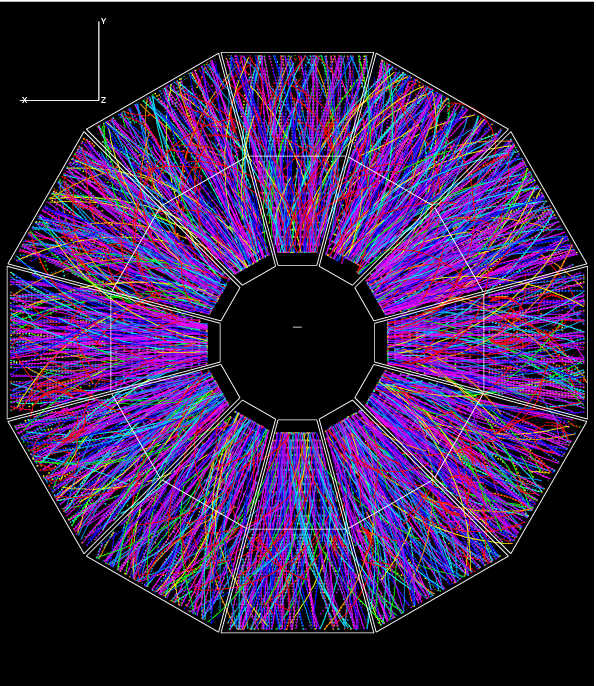
Above: Collision event in the STAR. |
| Finding Υ (Upsilons)
The pictures on the right show events in STAR and CMS with Upsilon candidates. In STAR, we searched for decays into electron-positron pairs. In CMS, we searched for muon-antimuon pairs. In STAR, one can see the response of the electro-magnetic calorimeter detector given by the more than 1000 detector boxes (shown mainly in green and blue) making up a cylinder. When an electron or a photon strikes the calorimeter, it will deposit all its energy in the detector. We can measure the energy, and we can visualize the response of the detector by drawing a taller box with a different color when the energy is large. In the collision event shown at right, there are a few detector modules that show a high energy deposition, shown as the yellow and red boxes sticking out above the blue and green. These are consistent with a signal from high energy electron and its anti-paricle. The Υ (and the J/ψ) can decay into one electron and one positron, each with high energy (which comes from the large mass of the parent Υ or J/ψ thanks to E=mc2). One can also see that there are also thousands of tracks seen in the display. However, once we measure their momentum and other properties, we see that only two of them are of sufficiently high energy and consistent with being electrons or positrons. This gives us a tell-tale sign of an Upsilon decay. In the CMS detector, we can clearly see two opposite sign muon tracks in the event, the two red lines that reach the outermost part of the detector. Most of the other particles in the event, pions, Kaons, and protons, are measured in the tracker but they are stopped by other detector components. Only muons escape, making it easy to trigger on them. Therefore, whenever we see events like the ones on the right, the detector system is programmed to record it for further study. By recording millions of such events, we can measure the properties of these particles and see if they get modified in the hot environment left in the wake of a heavy ion collision. |
|
External Links
| Article on RHIC and QGP physics
Sci. Am. May/06 |
Prospects for Quarkonium in STAR (Link to STAR Note) |
STAR Heavy Flavor Working Group (password protected)
|
STAR Experiment | ||
| Brookhaven Overview Video | Brookhaven on Jeopardy! The "3-D digital camera" mentioned in the video refers to the STAR Time Projection Chamber. |
The "perfect liquid" video. | Particle Adventure Home Page | CMS Experiment | |
| Hot quark soup and parity. | Colliding nuclei at high energy. |

